Parsons Dance performs at the Joyce Theater through January.
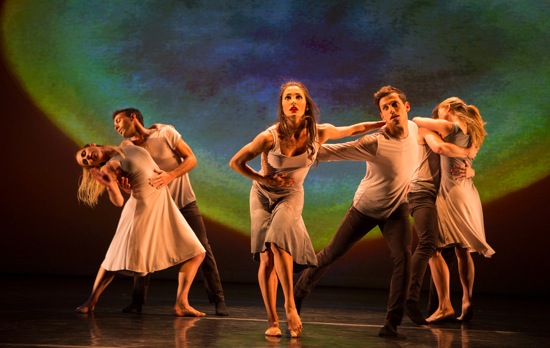
David Parsons’ Finding Center. (L to R): Sarah Braverman, Omar Román de Jesús, Elena d’Amario, Ian Spring, and Geena Pacareu. Photo: Yi-Chun Wu
Last year, the dance company founded by choreographer David Parsons and lighting designer Howell Binkley turned thirty, but it seems eternally young and optimistic. Its eight terrific dancers are as exuberant and tireless as teenagers. No perils appear to await them as they cavort in their vividly colored world. On a Thursday night, the audience for Parson Dance’s season at the Joyce Theater (January 20 through 31) is in love with what they see. The spectators—neither predominantly young nor particularly old—respond like fans. You could compare Parsons’ work to comfort food prepared by an imaginative chef, although “comfort” might be misleading, given the athleticism and endurance of the dancers. What I mean is that, in a wintry and dangerous world, folks want to feel good whenever they can. Parsons’ 1982 solo Caught, which appears on every program and can be performed by a man or a woman, shows us, via meticulously timed flashes of strobe light, a dancer who can appear to fly. And who wouldn’t be uplifted by such a possibility?
Throughout the program, the dancers seem always in motion—sprinting swooping, skipping, spinning, leaping. They trace big, breath-caught loops of movement on the air or pierce it with straight-armed gestures. They drop to the floor on a dime and are on their feet in a second. Pausing is for sissies. And they charm you—whether that is their clear intent or simply a by-product of their dancing.
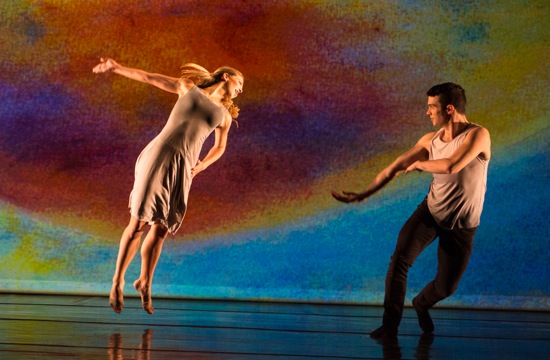
Geena Pacareu and Omar Román de Jesús in Finding Center. Photo: Yi-Chun Wu
The company’s Joyce program offers six dances in all, and no time is wasted on either side of the intermission. From Parsons’ New York premiere, Finding Center, through his 1993 Union, to Robert Battle’s 2008 Train, performers evidently make their costume changes at top speed, as does the Caught soloist of the evening (I saw Elena d’Amario), who has previously danced in Katarzyna Skarpetowska’s Almah (a world premiere), and then must join the others in Parsons’ 1990 Nascimento.
Although Parsons runs a tight ship, that’s a very full program. In addition, both Finding Center and Almah feel long. In Finding Center, the music, five recorded pieces by Thomas Newman, progresses via repeating motifs, and after a while it seems like a train that has decided not to make stops. The dancers can’t get off, and Parsons has them follow the music’s rhythms quite closely much of the time. Amid the many handsome images, you may yearn for a stop, or a phrase that arches over several measures of music.
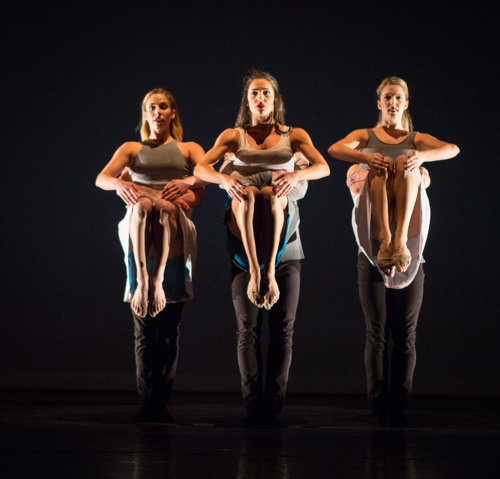
L to R: Sarah Braverman, Elena d’Amario, and Geena Pacareu. Hidden: Ian Spring, Omar Román de Jesús, and Eoghan Dillon. Photo: Yi-Chun Wu
The opening vision is piquant. Sarah Braverman, Geena Pacareu, and D’Amario are on their feet, dancing in unison facing us; behind them, Ian Spring, Omar Román de Jesús, and Eoghan Dillon lie curled up on their sides, as if taking a nap. However, before long, they’re standing as well, in their own line behind the women and perfectly in sync with them. (I was primed for something stranger.) Later, there’s a bit of counterpoint, and pretty soon, the men and women pair up, after which two couples crawl away in darkness so d’Amario and Spring can have a little privacy. These two are especially splendid dancers. They make the various imaginative lifts seem almost spontaneous, yet with the fluidity that comes with only from expertise and hours of practice. I’d been watching d’Amario from the start—not only for the fullness of her movements, but for the clarity of her focus.
I’m not sure what the center of the dance is, but it’s clear enough in Rita Blitt’s stunning paintings, which are projected, one by one, on the cyclorama. These images, dating from the 1980s, show the same basic shape, an oval, laid horizontally, but each has a different rich assembly of colors; at least one projection faintly resembles an eye.
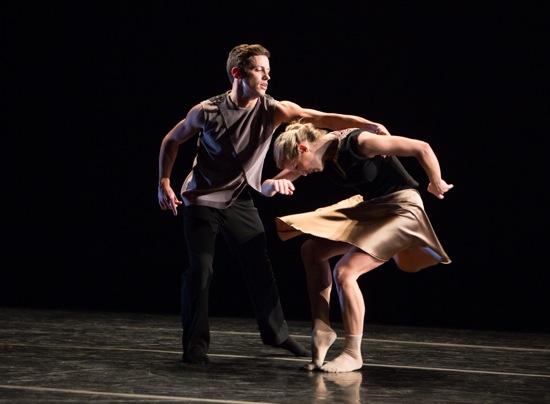
Ian Spring and Geena Pacareu in Katarzyna Scarpetowska’s Almah. Photo: Yi-Chun Wu
Almah, Skarpetowska’s second work for Parsons Dance, evokes her birthplace, Poland, and the score by the Russian composer LJOVA (Lev Zhurbin) supports the dance marvelously. It’s also a treat to hear the music performed live on tuba, trumpet, drums, clarinet, accordion, fadolin (a six-string violin played by Zhurbin), and by singer Inna Barmash. In this piece, Pacareu might stand in for the choreographer channeling memories of her native land. She dances alone and with Spring. Two other couples come and go: d’Amario and de Jesús, Zoey Anderson and Dillon. The atmosphere is that of a celebration with a bittersweet edge.
Skarpetowska was a member of Parsons Dance from 1999 to 2006, and, as in his works, the dancers swing lushly in and out of the steps and patterns. One brief image struck me. The two couples are near a corner of the stage, Pacareu slips her hand for a second into—as I recall—Anderson’s hand, while Spring watches from a distance. The gesture is unlike anything else in the evening, and it made me wish for more such unpredictable and subtly intimate moments.
Battle also danced with Parsons’ company (from 1994 to 2001), and perhaps an inherited love of non-stop energy fueled Train, which he made for River North Chicago Dance Company in 2008. The recorded music by Les Tambours du Bronx drives the six dancers on with its artillery-fire drumming and fierce yelling, and Binkley’s lighting conveys sudden changes along this train trip—beams along the floor, a blast of white light that makes the dancers flinch. But they’re unstoppable. They can drop into a seated position from a jump, punch the air and vault into it. Battle is adept at contrasting marching with, say, forming a line and gesturing, between a suspended step and a plunge into swifter, busier activity. Braverman is notable in a solo; so is de Jesús.
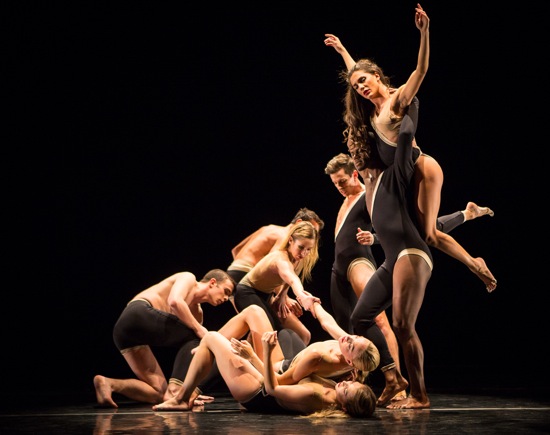
David Parsons’ Union. On floor: Omar Román de Jesús, Joey Anderson atop Geena Pacareu; (L to R): Eoghan Dillon behind Sarah Braverman, Ian Spring, Ahmad Simmons lifting Elena d’Amario. Photo: Yi-Chun Wu
Parsons’ 1993 Union precedes Train, and it has a slightly different flavor from the rest of the program. The fine Elegy from John Corigliano’s Concerto for Clarinet and Orchestra accompanies it. All eight of the dancers (that includes Ahmad Simmons) enter in near slow motion along a diagonal, indicating various other diagonal paths with their arms. When they reach the center of the stage and a pool of light, they create a kind of benign snake pit. This performer goes up, this one goes down; he steps over, she crawls under; bridges and tunnels form and dissolve. Although these are human beings helping one another, the overall image is of a molecule under attack, trying to reform. This goes on for a long time, but a pattern never emerges. Gradually the dancers spread out into the same slow procession with which they entered and head offstage.
The more you watch these dancers the more you admire their stamina and dedication, to say nothing of their brilliance. They treat the choreography as an offering that they enjoy giving. In addition to all the above, Parsons provides a closer: Nascimento set to a score by Milton Nascimento, I confess to being groggy by now, but we get to see the performers in brief solos that pop out of the gush of dancing in a magical world whose sky can be orange while the light shed on them is blue. The speed increases. After all the dancing they’ve done tonight, they can still vault into the air and kick both legs to one side before they land. And fall. And rise. And keep going.
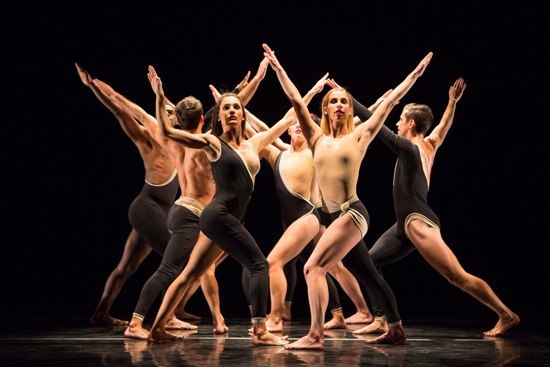
David Parsons’ Union. Foreground: Elena d’Amario (L) and Sarah Braverman. Photo: Yi-Chun Wu

I remember seeing Parsons dance “Caught” himself, possibly in 1982 or 1983, here in Portland, Oregon where his company was one of the first to appear with Portland State University’s much lamented Contemporary Dance Season. I remember writing that he looked like a cross between an Iowa farm boy and a Renaissance angel, which he did. In the intervening years, I’ve seen “Caught” performed many times by many different dancers, most recently by I can’t remember who with the Dance Theatre of Harlem. No one has done it in quite the way Parsons did himself, nor for this viewer, had quite the impact.
I’m with you, Martha. Your description of the young David Parsons is perfect. Among other performances of Caught that I’ve seen, only one ineradicable image keeps coming back to me: that of Gary Chryst (neither angel nor farm boy and very powerful).